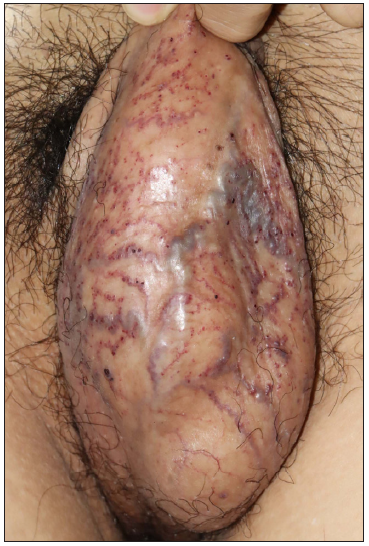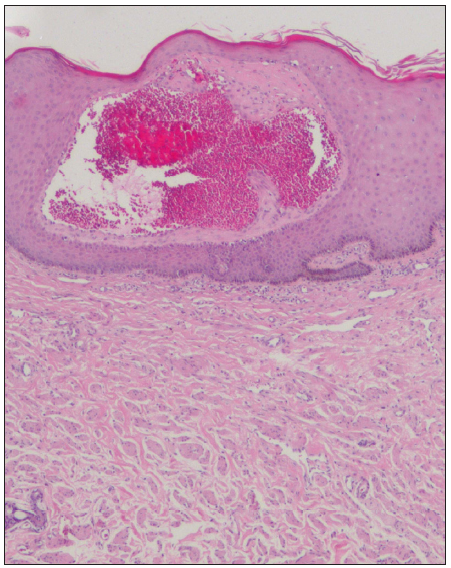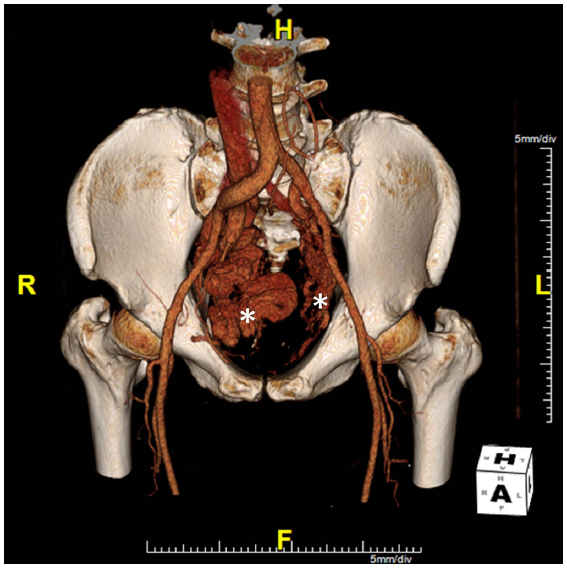Translate this page into:
Refractory angiokeratoma of Fordyce: A manifestation of pelvic arteriovenous malformations
Corresponding author: Prof. Stephen Chu-Sung Hu, Department of Dermatology, College of Medicine, Kaohsiung Medical University, Kaohsiung, Taiwan. stephen@kmu.edu.tw
-
Received: ,
Accepted: ,
How to cite this article: Fang W-C, Su Y-C, Chiu L-W, Hu SC-S. Refractory angiokeratoma of Fordyce: A manifestation of pelvic arteriovenous malformations. Indian J Dermatol Venereol Leprol. doi: 10.25259/IJDVL_257_2024
Dear Editor,
Angiokeratoma of Fordyce usually manifests as multiple vascular papules on the scrotum or vulva of adults and elderly patients. Venous hypertension induced by inguinal hernia, varicocele and epididymal or genitourinary tumours may contribute to the development of Fordyce angiokeratomas. 1 We hereby report a case of refractory angiokeratoma of Fordyce associated with bilateral pelvic arteriovenous malformations.
A 44-year-old man presented to our dermatology clinic with multiple, tiny, firm, erythematous papules [Figure 1a] and tortuous dilated veins with telangiectatic vessels on his scrotum [Figure 1b] for 7 years. Intermittent pinpoint bleeding was noted without pain or pruritus. Physical examination revealed no inguinal lymphadenopathy or hernia. Skin biopsy revealed epidermal acanthosis and dilated thin-walled capillaries within the superficial dermis [Figure 2], consistent with a diagnosis of angiokeratoma of Fordyce. The angiokeratomas were treated with multiple courses of cryotherapy with limited clinical response. The patient also complained of lower abdominal pain and urinary frequency with nocturia for many years. Abdominal computed tomography angiography revealed bilateral arteriovenous malformations in the pelvic cavity [Figure 3]. The right arteriovenous malformation was supplied from the proximal right internal iliac artery and drained into the right internal and external iliac veins. The left arteriovenous malformation was supplied from the proximal left internal iliac artery and drained into the left internal iliac vein. The patient was thus diagnosed with refractory angiokeratoma of Fordyce associated with bilateral pelvic arteriovenous malformations. The patient was reluctant to receive endovascular embolization for arteriovenous malformation due to potential risks and his skin lesions continued to persist.

- Clinical images showing multiple tiny erythematous papules and tortuous dilated veins with telangiectatic vessels on the scrotum.

- Close-up view of erythematous papules, tortuous dilated veins and telangiectatic vessels on the scrotum.

- Skin biopsy showed epidermal acanthosis and dilated thin-walled capillaries within the superficial dermis (Haematoxylin and Eosin, 40x).

- Computed tomography angiography revealed bilateral arteriovenous malformations (white asterisks) in the pelvic cavity, R = Right, L = Left, H = Head, F = Foot.
Angiokeratoma of Fordyce is a benign vascular condition which presents as multiple, dark red or blue, dome-shaped papules on the scrotum or vulva, usually ranging from 1 to 5 mm in diameter. It is histologically characterised by dilated capillaries in the papillary dermis and hyperkeratosis and acanthosis of the epidermis. Most lesions can be left untreated if asymptomatic. Treatment modalities include surgical excision, cryotherapy, electrocautery, laser therapy and sclerotherapy. Possible pathophysiological mechanisms associated with the development of angiokeratoma of Fordyce include reduction of vascular supportive elastic tissue, local injury to dermal capillaries and chronic scrotal venous hypertension. 1,2 Increased venous pressure in the scrotal veins due to hernias, epididymal or urinary tract tumours and varicoceles may be related to the development of angiokeratoma of Fordyce. 1 Arteriovenous malformation, a high flow vascular lesion, is characterised by multiple abnormal blood vessels connecting arteries and veins. Large pelvic arteriovenous malformations may present with various pelvic symptoms due to increased venous pressure or mass effect, such as lower abdominal pain, urinary frequency, haematuria, dysuria, urinary retention and impotence, but cutaneous manifestations are rarely seen. 3 Extrapelvic symptoms such as lower limb venous hypertension may also be present. 4 Venous drainage of the scrotum is mainly composed of anterior and posterior scrotal veins, which drain through the external and internal pudendal veins into the external and internal iliac veins, respectively. 5 In our case, the pelvic arteriovenous malformations could have increased the venous pressure of the internal and external iliac veins, resulting in venous hypertension of the scrotal veins with the subsequent development of tortuous dilated scrotal veins and angiokeratomas.
There are a few prior reports of angiokeratomas associated with arteriovenous malformations or fistulas. Calzavara-Pinton et al. reported a family whose members were affected by angiokeratoma corporis diffusum and arteriovenous fistulas involving the lower limbs, 6 and Abtahi-Naeini et al. reported a patient with Cobb syndrome who presented with a lumbosacral angiokeratoma-like skin lesion and spinal arteriovenous malformation. 7 To our knowledge, this is the first reported case of refractory angiokeratoma of Fordyce associated with bilateral pelvic arteriovenous malformations. We propose that pelvic arteriovenous malformation is a potential cause of venous hypertension and should be considered in Fordyce angiokeratomas recalcitrant to treatment, particularly if tortuous dilated scrotal veins and pelvic symptoms are also present.
Declaration of patient consent
The authors certify that they have obtained all appropriate patient consent.
Financial support and sponsorship
Nil.
Conflicts of interest
There are no conflicts of interest.
Use of artificial intelligence (AI)-assisted technology for manuscript preparation
The authors confirm that there was no use of artificial intelligence (AI)-assisted technology for assisting in the writing or editing of the manuscript and no images were manipulated using AI.
References
- Fordyce angiokeratomas as clues to local venous hypertension. Arch Dermatol. 2005;141:1325-6.
- [CrossRef] [PubMed] [Google Scholar]
- Unilateral angiokeratoma of the scrotum (Fordyce’s type) associated with a contralateral varicocele. Indian J Dermatol Venereol Leprol. 2017;83:470-2.
- [CrossRef] [PubMed] [Google Scholar]
- Congenital pelvic arteriovenous malformation in male patients: a rare cause of urological symptoms and role of embolization. Eur Urol. 2002;42:407-12.
- [CrossRef] [PubMed] [Google Scholar]
- Congenital pelvic arteriovenous malformation: uncommon symptoms of lower limb venous hypertension. J Cardiovasc Surg (Torino). 2001;42:825-7.
- [PubMed] [Google Scholar]
- Microsurgical subinguinal varicocelectomy in children, adolescents, and adults: surgical anatomy and anatomically justified technique. J Androl. 2012;33:338-49.
- [CrossRef] [PubMed] [Google Scholar]
- Angiokeratoma corporis diffusum and arteriovenous fistulas with dominant transmission in the absence of metabolic disorders. Arch Dermatol. 1995;131:57-62.
- [CrossRef] [PubMed] [Google Scholar]
- Unusual cause of lower extremity wounds: Cobb syndrome. Int Wound J. 2016;13:1009-10.
- [CrossRef] [PubMed] [Google Scholar]





